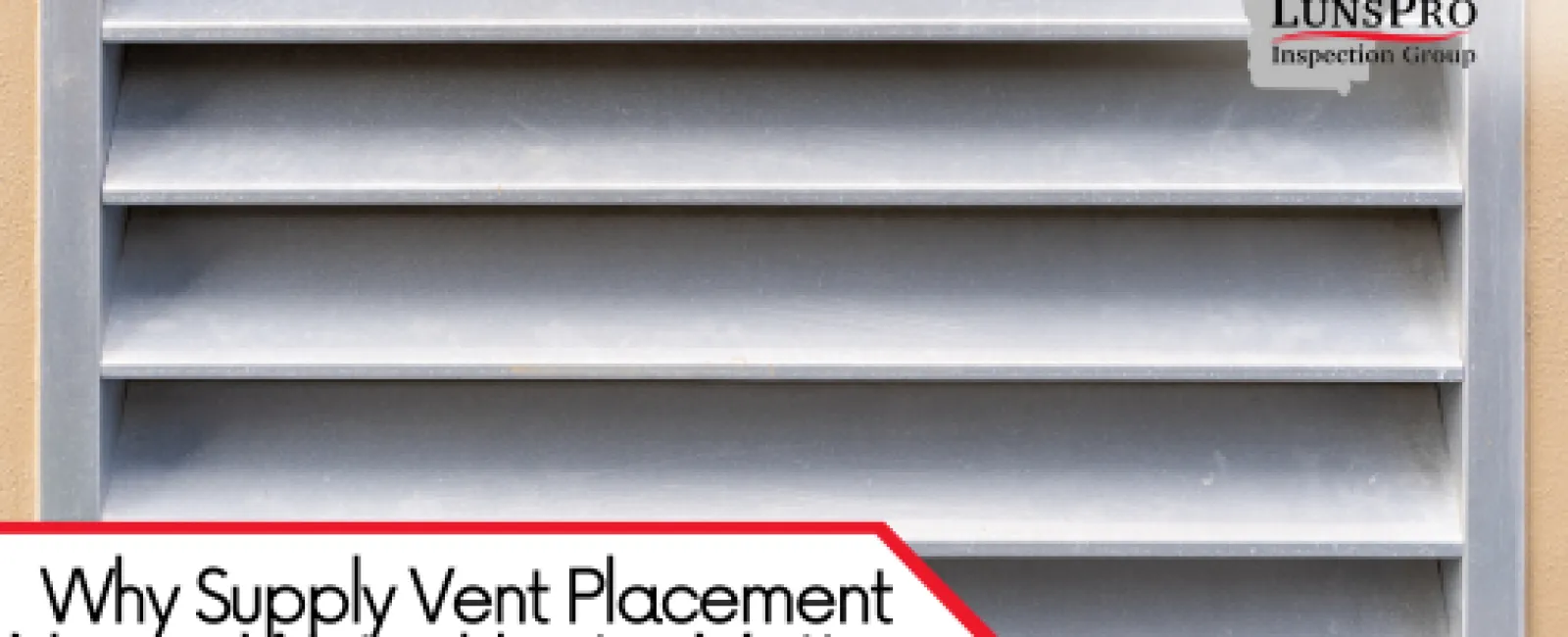When most people think about home inspections, their minds often go straight to the obvious: roofs, foundations, or plumbing leaks. But many of the most important findings during a professional inspection are far less noticeable. Small details, like the placement of a supply vent near a water heater, can have serious implications for safety, efficiency, and long-term comfort in your home.
At LunsPro Inspection Group, our certified inspectors routinely identify situations where seemingly minor issues deserve careful attention. A misplaced vent, for example, may not seem urgent to a homeowner, but it can signal the need for follow-up with an HVAC contractor. This type of insight highlights the importance of comprehensive Southeastern home inspections—not only to uncover visible concerns but also to detect subtle conditions that could compromise safety or lead to higher energy costs.
The Role of Supply Vents in Your Home
To understand why vent placement matters, it helps to know what supply vents do. Supply vents are part of your HVAC system and are responsible for delivering conditioned air—either cooled or heated—throughout your living spaces. Proper vent placement ensures even distribution of air, optimal efficiency, and balanced indoor comfort.
When vents are incorrectly located, however, they can interfere with other systems, cause energy waste, or create hazardous conditions. That's why Southeastern residential and commercial inspections include a careful look at HVAC components and their surroundings. Something as simple as the proximity of a vent to your water heater can have consequences worth addressing.
Why a Vent Near a Water Heater Raises Concerns
1. Potential Safety Hazards
Water heaters, especially gas-fired units, require a steady supply of oxygen for combustion and must safely vent exhaust gases outside the home. If a supply vent is located too close, it can create airflow imbalances. In some cases, this may disrupt proper combustion, leading to backdrafting—a situation where harmful gases like carbon monoxide re-enter the living space.
2. Energy Efficiency Issues
When conditioned air is released near a water heater in a utility area, it isn't serving its intended purpose of heating or cooling your living areas. This results in wasted energy, higher utility bills, and unnecessary strain on your HVAC system.
3. Comfort and Performance Problems
Air delivered near appliances rather than living spaces can reduce overall system effectiveness. You may notice rooms not staying as warm in winter or cool in summer, even though your system is running more often than it should.
4. Code and Manufacturer Concerns
In many areas, building codes and HVAC installation guidelines specify clearances between vents, appliances, and other mechanical systems. A misplaced vent could be a sign that installation didn't follow best practices, warranting a closer look by a licensed HVAC contractor.
The Bigger Picture: HVAC and Water Heater Interactions
Your HVAC system and water heater are two separate components, but they often share space in a utility closet, basement, or garage. This proximity means their interactions matter more than many homeowners realize. For example:
-
Air Circulation: Supply or return vents located near combustion appliances can create negative pressure, pulling exhaust gases back inside.
-
Moisture Control: Warm or cool air flowing around a water heater may contribute to condensation, which can damage nearby materials or encourage mold growth.
-
System Wear: If your HVAC system is "losing" air to mechanical areas, it has to work harder to maintain comfort, leading to premature wear on equipment.
By flagging vent placement issues, Southeastern home inspections help ensure these systems don't work against each other.
Why Professional Inspections Make a Difference
Homeowners in Georgia and the Carolinas face unique challenges when it comes to heating and cooling. High humidity, seasonal temperature swings, and older housing stock mean HVAC systems often operate under demanding conditions. LunsPro Inspection Group provides Southeastern residential and commercial inspections that take these regional factors into account.
Certified inspectors don't just glance at appliances—they evaluate how systems interact, where risks may exist, and whether professional follow-up is advisable. In the case of a vent near a water heater, an inspector's recommendation to call an HVAC contractor is based on experience and a commitment to homeowner safety.
Common HVAC and Vent Issues Uncovered in Inspections
While vent placement near a water heater is one example, Southeastern home inspections often uncover related HVAC concerns that homeowners should know about:
-
Blocked or Closed Vents: Reduces airflow and creates uneven temperatures throughout the home.
-
Leaky Ductwork: Wastes conditioned air and increases energy bills.
-
Improper Returns: Poor placement of return vents can pull air from the wrong areas, affecting comfort and efficiency.
-
Undersized or Oversized Systems: Incorrectly sized HVAC units struggle to maintain comfort and shorten equipment lifespan.
-
Inadequate Clearances: HVAC systems installed too close to walls, ceilings, or other appliances may not function safely or efficiently.
Each of these issues reinforces the value of professional inspections that look beyond surface appearances.
Steps Homeowners Can Take
If you're concerned about your HVAC system or the placement of vents near your water heater, here are a few steps to consider:
-
Schedule an Inspection: A certified home inspection from LunsPro Inspection Group provides a comprehensive overview of your home's condition, including HVAC and mechanical systems.
-
Consult HVAC Professionals: If vent placement issues are found, an HVAC contractor can evaluate airflow, adjust ductwork, or recommend system improvements.
-
Check for Warning Signs: Be alert to unusual odors, backdrafting, high energy bills, or uneven heating and cooling. These may signal airflow or vent placement issues.
-
Maintain Regular Service: Annual HVAC maintenance and water heater checks help ensure both systems operate safely and efficiently.
-
Upgrade When Necessary: If your HVAC or water heater is outdated, modern replacements often include improved safety features and efficiency standards.
How This Applies to Georgia and Carolina Homes
In Georgia, South Carolina, and North Carolina, many homes were built decades ago and may not reflect modern building codes or best practices. Renovations and additions can also lead to unusual mechanical layouts where vents and appliances share limited space. Homeowners should be especially vigilant in older neighborhoods around Atlanta, Charleston, and Charlotte, where retrofits sometimes create less-than-ideal conditions.
Southeastern home inspections bring these issues to light before they cause problems. Whether you're buying a new home, selling a property, or simply maintaining your residence, detailed inspections ensure your systems are safe, efficient, and ready to handle the region's climate.
Homeownership in the Southeast is rewarding, but it requires attention to details that aren't always obvious. The placement of a supply vent near a water heater may not seem significant at first glance, yet it can signal deeper issues with safety, efficiency, or installation practices. By identifying these concerns early, homeowners can avoid costly repairs, prevent dangerous conditions, and keep their homes operating smoothly.
At LunsPro Inspection Group, we believe that knowledge is a homeowner's greatest tool. Our Southeastern residential and commercial inspections are designed to uncover the hidden details that matter most—from vent placement to foundation health. For homeowners across Georgia and the Carolinas, investing in thorough inspections means making informed decisions, protecting your investment, and ensuring a safe, comfortable living environment for years to come.

